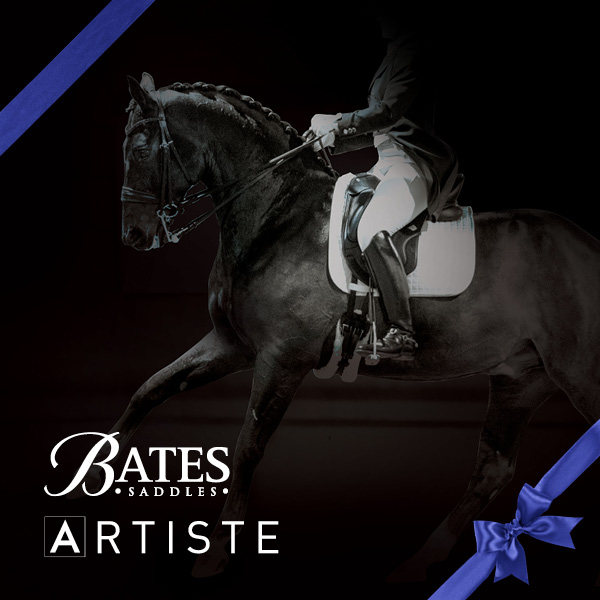Words and images: Rebecca Ashton
Gareth Hughes is like Pharlap. He wasn’t born in Australia, but we like to claim him as our own. Although British by birth, he spent his formative years in Queensland riding Arabs with dreams of being a cowboy. He never planned to return home, but the idea that spending a couple of years back in England and gaining an accent would mean he could charge more for lessons back in Australia seemed logical to the young Gareth and sent him packing. When it became obvious that dressage was the career path he was going to take, it made sense to remain in the UK.
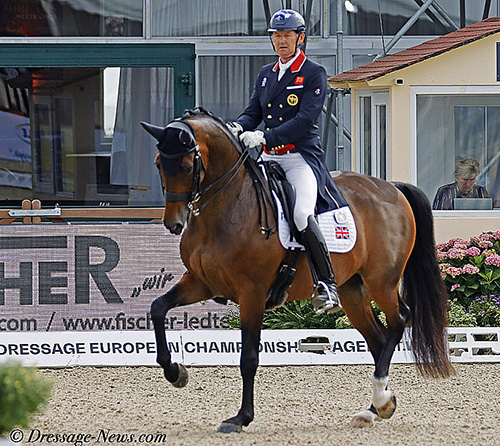
Since then he has been on champion medal winning British dressage teams and he’s learnt his craft exceedingly well. So it was a great coup when Kate O’Connor could convince her friend to travel Down Under and teach some clinics and Sally Ann Barbara for grabbing him for an afternoon to educate the accredited coaches of Equestrian NSW. I was lucky to sit in and see what the Brit was about. This clinic was really addressing coaches and how best to navigate the way forward with each student.
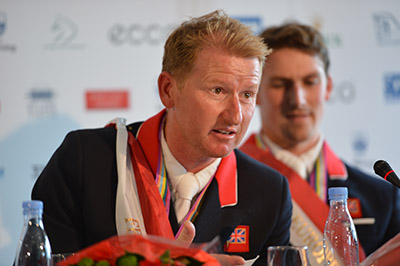
A medal at the WEG in Herning in 2013
Gareth has one goal in mind when he’s training: produce a good Grand Prix mount. “Don’t make it about the exercise, make it about where you are and where you want to get. Our job is to ride a dressage test.” It’s about the simplest way for the horse and mainly using just what’s in the tests. “If you put something else in to help, you have to take it out again.” From a coach’s perspective, “…. the hardest thing is keeping it simple. Don’t over complicated things so you feel you’re being proactive.”
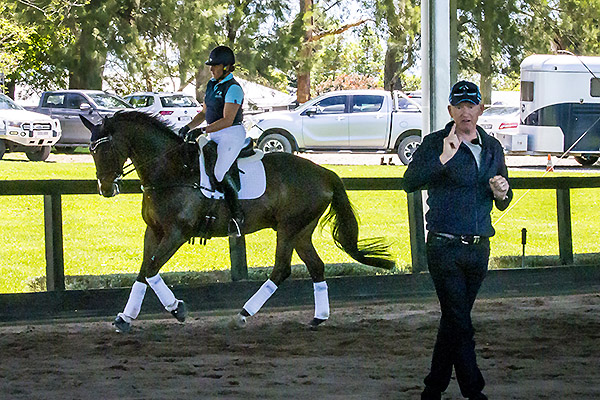
Christine Bates and her successful eventer, the Thoroughbred, Fleeting…
The clinic started at Medium level with event rider Christine Bates as the guinea pig aboard her Thoroughbred, Fleeting. Right from the start the question is, ‘Would the judge like this?’ The work is about getting the marks. The route may not be easy, but short cuts never work. It’s also important as a coach to realise you’re not a judge. Your job isn’t to tell them how good or bad something is per se, but how to develop the combination in the best way possible. It’s like a jigsaw puzzle, but you need to know what the finished picture will look like first. With that in mind, not every horse will be great at every level. If you’re struggling with a level, keep pushing on. Grand Prix is the final goal after all. And the Grand Prix test for each horse may not win you Olympic gold, but it should be the gold medal for that particular horse.
Once the horse reaches Medium, it should have the basic expression of an Advanced horse, when it reaches Prix St Georges, it should have the basic impression of a Grand Prix horse. From then, you just keep building the horse’s strength so whatever you ask of them, they can give the correct response.
So, where to start? Gareth believes the three most important things for the horse’s training is balance, rhythm and contact. After that comes impulsion. The other point to note is that no Grand Prix horse has any natural suppleness left. They are older by now so the suppleness has to be trained and maintained. “Knowledge stays but suppleness doesn’t.” As you go up the levels, less test movements are based on paces and more about how you execute the movements; precision and correctness. It all starts with good, basic control.

First watch the combination working around in front of you – Christine is the rider
Gareth says that when you first watch a combination working around in front of you, your first thought should be are they together? A horse might be traveling around beautifully, but is it on the aids, for example? Can the rider adjust the horse’s balance and influence the frame? “I don’t care about the quality of trot or canter or suppleness at this stage. I care if horse is following the rider. Then, how do I develop the quality of the paces? Where do I start?” You have to meet the combination where they are and develop them from there. Don’t sit there and point out everything that’s wrong. You need to give the rider tools so she can continue on her own after the lesson.
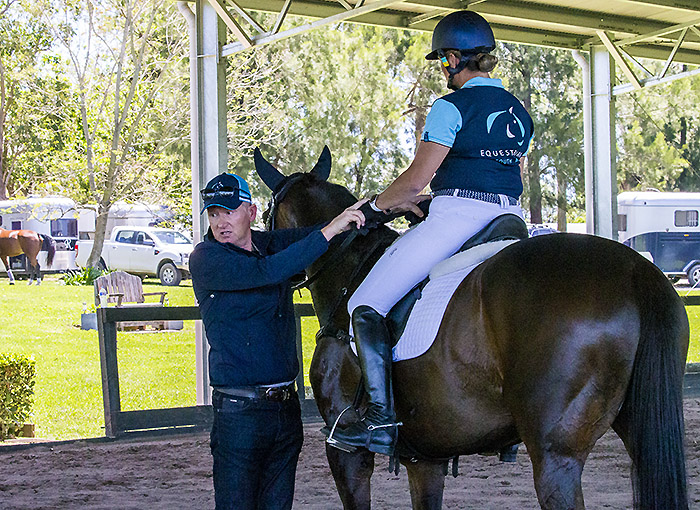
Gareth much prefers starting most horses off in the canter. It’s usually easier for them to swing along and then the trot improves. The circle is used to get what you want and the full school is used to test it. “You have to be able to go past every single letter with the canter you want.” If not, circle and get the quality back. Gareth’s work is simple; nothing is over complicated. Forward and back, loosen the horse’s jaw, make sure the collected canter is forward thinking, create activity. Once the ‘base pace’ is found, the rider can go off and find suppleness. Is trot easier for them than canter? Where is the horse sticky? In the jaw? In the rib cage? These are all questions the coach should consider.
It’s important as a coach to understand where your rider’s natural abilities and inabilities lie.
Feeling evolves, but not always well. Does your rider have good feeling in the seat and legs but not so much in the hands? “Position is very important. Subtle changes really make a difference.” The same with technique. “Don’t ride the down step of the canter, ride the up step to collect.” Transitions will get you so far, but then you have to be able to take the work into the test movements and exercises. You just keep adding to what’s been set up. Nothing should deteriorate when the exercises are executed.
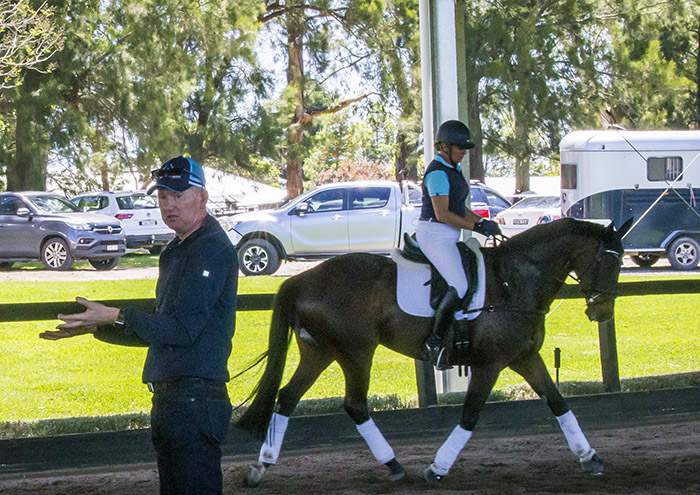
Shoulder in, leg yield…help your rider find the correct aids, the correct execution of the aids and the correct pressure in the aids to help the horse at that particular moment. How often the aid should be given, the release of the aid. For example, Gareth was helping Christine with her horse’s jaw, “….like a rusty hinge…..loosen the jaw then leave it. Once it’s loosened, you don’t need to do it again.” It’s also your job to help the rider understand how the progression of exercises work, why they’re in the order they are and how they flow on from each other. Should you execute that leg yield on one rein or both? Be smart with your coaching.
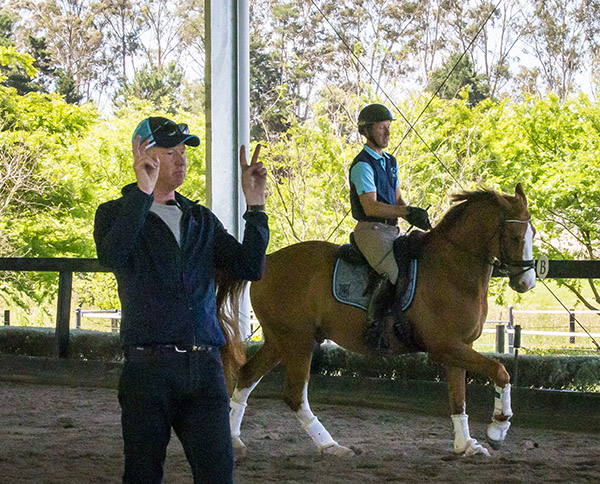
Justin Worthy and Benjamin Britten was next. Gareth commented that he doesn’t care if there are mistakes, but he wants to know what the rider does to correct them. The coach isn’t there to pull the combination apart, but to guide them and find solutions. The focus for this combination after the basic work was flying changes and it was here that Gareth emphasised the necessity for patience. “I think it can take 18 months to have changes really established. They’re hard because you have to stop and start them. You don’t want to be practicing them in the beginning of a week out from an Elementary test, for instance.”
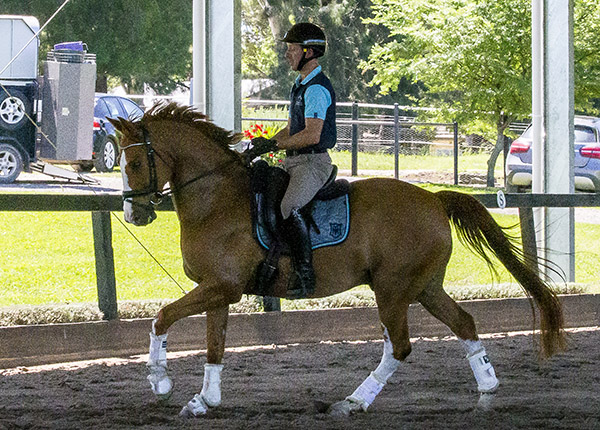
Gareth is always looking for the best place to start…
Gareth is always looking for the best place to start. “You have to enter the arena straight and with the poll up, so let’s start there. This horse twists himself because he finds it hard to carry, so let’s help him by getting the poll up first. Then we can look to see where the twisting is originating.” This process of ‘what to tackle when’ is important. You’re better to do one thing not six. Lifting the poll got the horse straighter which allowed Justin to hold the horse up better with the inside leg which improved the canter.
The exercises might need to be repeated a few times, initially for the horse’s understanding, and then for him to soften his body into it. If they anticipate an exercise, you have to make them softly wait. A lot of the time, it’s not about the exercise, but how you prepare for it, and how the horse goes into it. Patience is also needed if the horse is trying to answer your question, but getting it wrong. Just wait and guide until the right answer is given.
Once even suppleness is there, speed control is next on the list.
“Most horses are built on the forehand. Pushing hard with you seat will not lift the poll. Each aid deals with the part of the body it touches. If the horse looks up in flexion, he’ll look supple, if he looks down in flexion, he feels supple. The judge doesn’t care what it feels like.” The message… if he’s locked, unlock, but don’t just potter around with the horse’s head on the ground because it feels nice.”
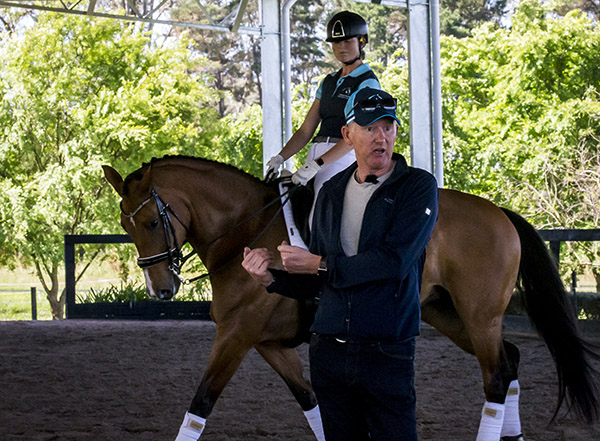
Rommy Sanna and Floriade
As a coach, it’s also important to know how long a combination has been together. When Rommy Sanna was asked how long she’d been riding her horse Floriade, and the answer was five years, Gareth continued, “Five years, now that’s not a work in progress. Five months…you can have a load of excuses.” It’s also important to ask the rider where they think they are in their training and how it’s going. It’s good to know where they are in their head, compared to what you’re seeing from the ground. But the Brit was quick to add that you shouldn’t say anything at the start of the session, “unless it’s a car crash”. Just observe, then be supportive. You’re there to help them be better. “It doesn’t matter how good someone is, how coachable are they?” You don’t always have to do something when you coach. Sometimes the work is good!
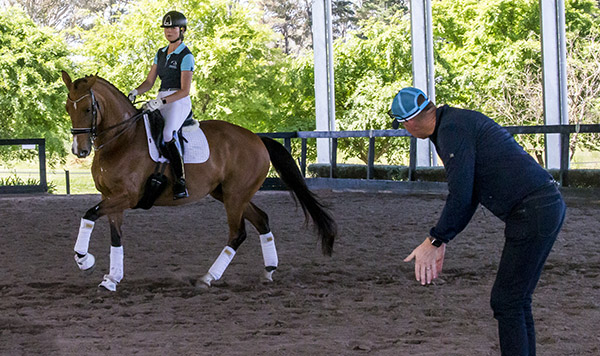
Gareth still wanted a good base, and control of those baseline paces. “There’s no use having exercises to get the movement better until you have the trot or canter that you want. The less control you have over the basic pace, the harder it is to make changes to it.” You have to be able to ride the horse, not have the horse just run forward. “If you add too much too soon, the horse doesn’t know if it’s Arthur or Martha. I want to see one canter through everything first.”
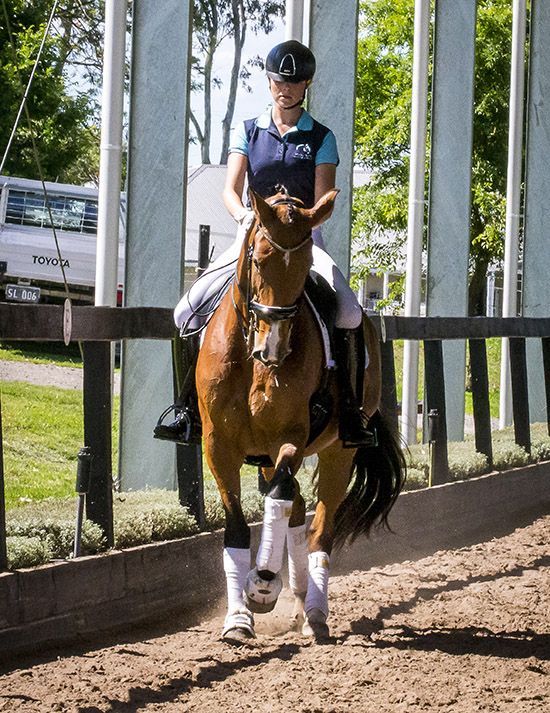
With a higher level Prix St George horse like Romy’s, often the horse’s knowledge of the movements isn’t the problem, rather the suppleness which may deteriorate in a stressful situation such as a competition. Romy’s mare was finding it hard to see how to get into the flying change. As a coach, Gareth had to make that all-important decision as to where to start. He chose the canter and working on getting the poll higher.
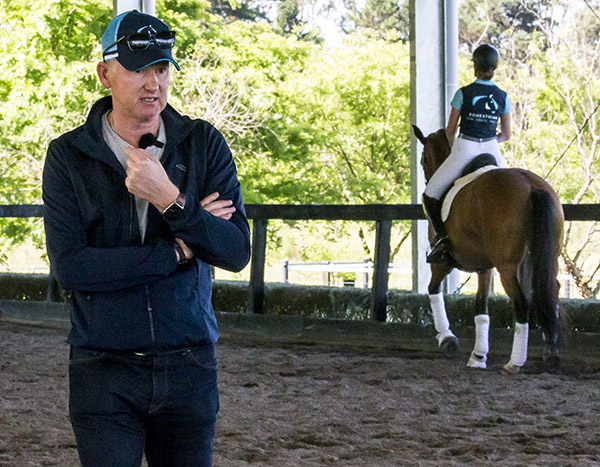
Gareth pointed out that although the horse’s hind legs were active, the canter seemed a little weak. His solution was leg yield. “Notice I always use the same exercises. You don’t need a thousand exercises.” The horse had to wait for the rider to take her into the exercises. “Don’t get inconsistent or the horse will get inconsistent. This situation is about patience. Getting her to wait, waiting for her to get it right without changing anything.” You don’t want the horse to guess. You have to be able to train anticipation and that builds consistency.
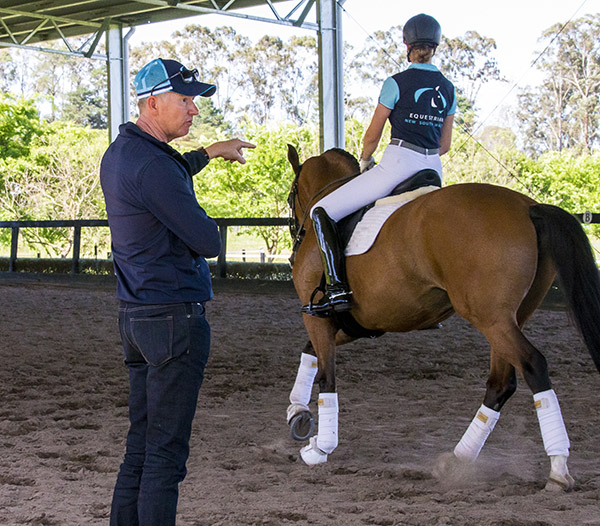
Gareth also looked for an exercise that could be repeated quickly without riding around the arena 100 times. For the changes he chose a tear drop from the corner back to the track, change and immediately into another 10m circle tear drop into the corner. If the horse lost balance, there was the option to repeat the circle to get her back.
It’s also important as a coach to understand if the horse in front of you is a body mover or leg mover. For body movers, you want to add more leg, so you might intersperse your trot work with rising trot.
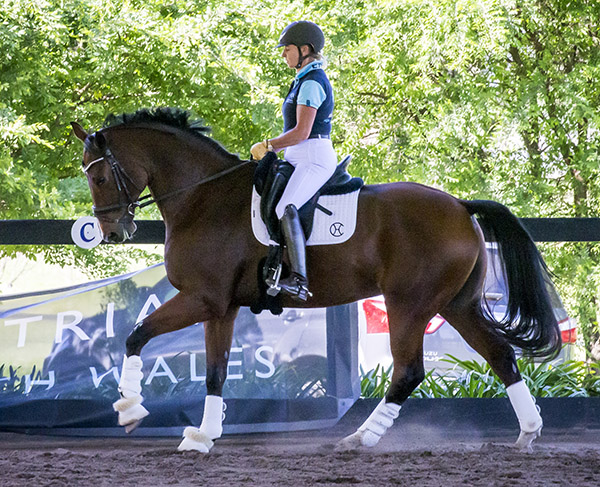
Caroline Hooper and Beck’s Gold
The final rider, Caroline Hooper was a good example of how to train people who know what to do. In that case, it’s about guiding them rather than telling them the step-by-step process. “I have to see what she does and think ok I think we need to add this or that. It’s difficult training top riders. It’s about giving them guidance and also seeing what they would see on the ground. When I have lessons with Carl (Hester), he doesn’t teach me how to ride, he reminds me to sit up or bend more.”
With Caroline’s horse Beck’s Gold heading to Grand Prix, it’s important to make sure there’s enough quickness to the hind leg. It was also a chance to address spookiness. If a horse has a ‘spooky corner’ in the test, you still have to get through that corner a lot of times. You have to be able to keep the horse moving. “He’s allowed to slow down and collect, but he can’t spook.” You have to give the horse a skill set in training that he can take into a more pressurised competition environment. With this horse, Gareth decided on a lot of leg yield to keep the horse’s attention, but not over face him with something too difficult. “Find the exercise that lets you find a way into the horse. Here we are using the leg yield. It wouldn’t work if we kept driving the half pass.” It’s also important to make sure the rider doesn’t get caught up in what the horse is doing and start doing unnecessary movements or aids.
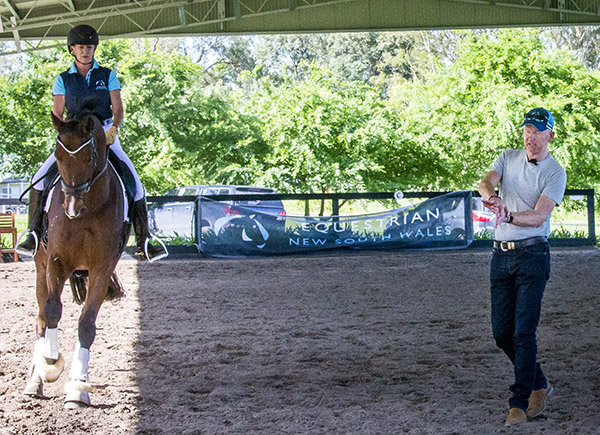
With the harder movements of Grand Prix such as the canter zig zag, tempi changes and piaffe/passage transitions, Gareth emphasised that you find your own way of counting and navigating the transitions. For example, for the zig zag, he would use one, two, three, four, straight, change.
For the coach, the guidance from the ground might be just changing the line the rider is on to help focus the horse more.
“You can only put so much into every horse. If you try to make it a 9 when he’s not capable of it, you’ll end up with a 5.5. If you keep it consistent and rhythmic, you’ll get a 7.” Then you’ll have a happy horse, a happy rider and a happy judge!
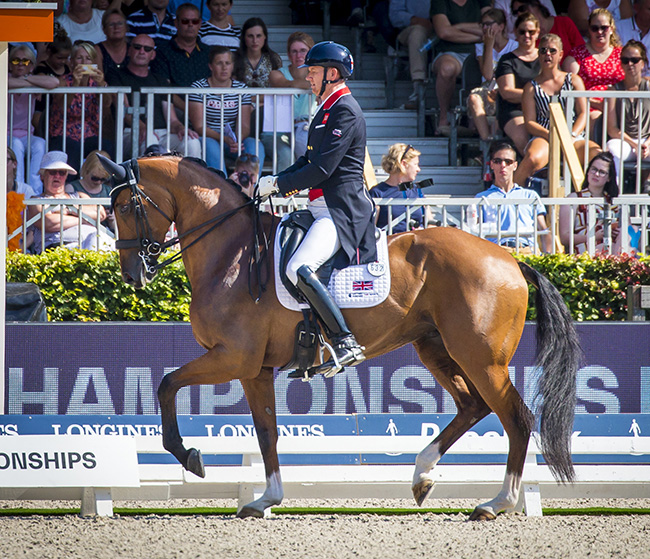
A big thanks to Gareth, Kate O’Connor of Equine Education Australia for bringing Gareth out, Sally-Ann Barbera, Coaching NSW and Equestrian NSW for organising the clinic. Di White for being a gracious host and the horses and riders who step into the arena and help us all learn.
Want to breed your own Champion in Australia? How about Totilas or one of his sons? Go to www.ihb.com.au
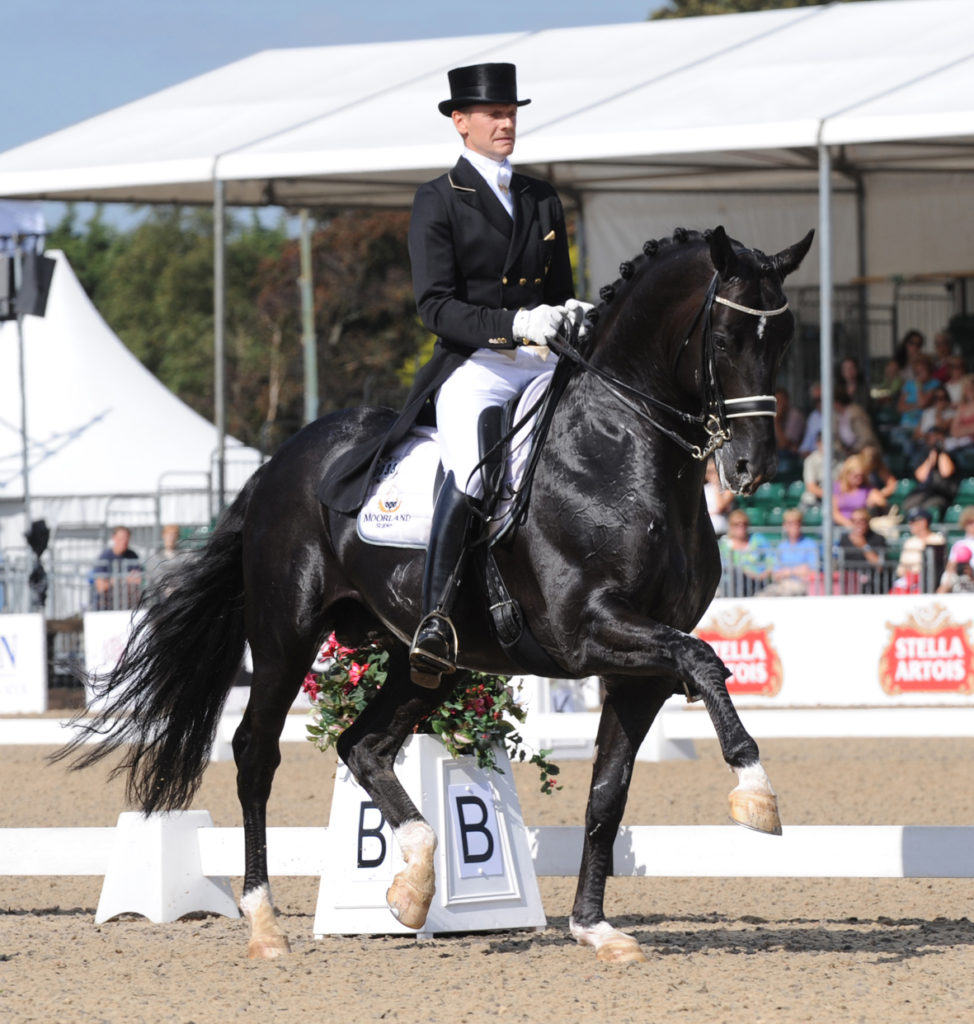
Totilas and Edward Gal winning at the Windsor Euros
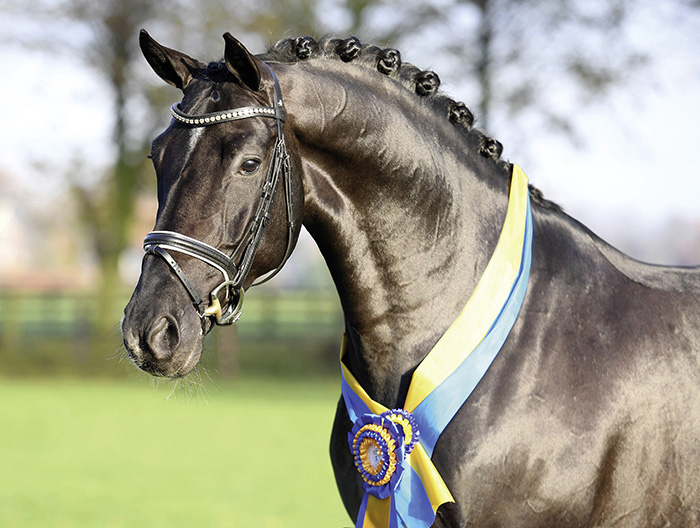
Or Total Hope also a winner and a sire…


